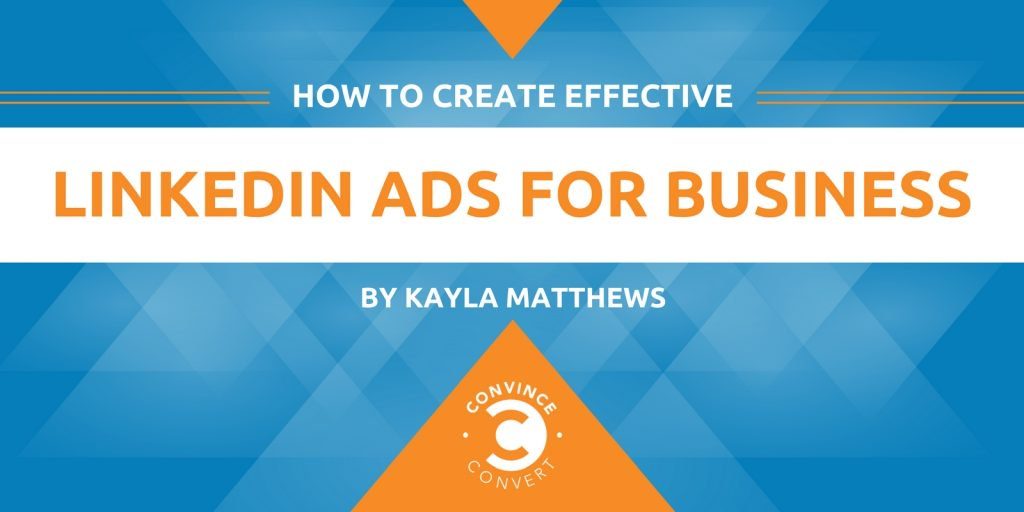There is no social media site more important for creating a professional image and networking with others in your industry than LinkedIn. With more than 430 million members, including leaders from each Fortune 500 company, the site has become the go-to network for professional purposes.
LinkedIn’s reach and reputation also make it an ideal place to connect with your audience through targeted ads. The site offers several options for these sponsored messages.
Types of LinkedIn Ads
On LinkedIn, you can create text ads, display ads, dynamic ads, sponsored content, and sponsored InMail.
- Text ads are the simplest ads on LinkedIn. They consist of a short bit of text and, optionally, a small image. They display on the top or right side of users’ screens.
- Display ads are standard visual ads that show up on the right side of LinkedIn’s main content.
- Dynamic ads display in the same spot as display ads, but use information from a user’s profile to personalize the ad to them. For example, it might tell them a connection of theirs joined a specific group or followed a certain company.
- Sponsored content displays natively in users’ regular feeds. Businesses can use it to promote content they post on their LinkedIn profiles or elsewhere online.
- Sponsored InMail takes personalized advertising one step further. It allows marketers to send personalized messages on LinkedIn to specific users. InMail arrives when the user is online and active in order to increase open rates.
Now that you know more about the options you have when placing ads on LinkedIn, here are six tips to help you create effective LinkedIn ads for your business, no matter which version you decide to use.
1. Show Your Expertise without Jargon
Strong copy is perhaps the most important indicator of how successful an ad will be. In order to create copy that reaches your audience effectively, you want it to convey that you’re knowledgeable about your industry without using too much jargon. Overusing industry lingo can make people less willing to engage with your ad.
Above is an example of sponsored content ads by HubSpot that do that exceptionally well. They make the content seem accessible, convey the company’s expertise, and inspire people to click on them.
Strong copy is perhaps the most important indicator of how successful an ad will be. Click To Tweet
2. Target Your Ads
71 percent of marketers say they use LinkedIn for their business, so there’s plenty of competition. To make sure your advertising gets to the right people, target it to them.
On LinkedIn, you can target by industry, job type, company, skills, groups people belong to, location, gender, and age. You should also, of course, try to create ads that will appeal to your target audience, the people most likely to take the action you want to inspire with your ads.
BI Worldwide, for example, realized that 80 percent of its desired audience was using LinkedIn at least weekly and took advantage of the site’s targeting capabilities to reach those people.
3. Add an Image
Including an image in your social media post can increase engagement by more than 150 percent. Relevant, high-quality images are powerful on social sites, including LinkedIn. Incorporating a picture into your LinkedIn ad can make it much more appealing to your audience.
When choosing an image, just make sure it fits with what you’re offering in your ad. It also has to work with the site’s white background and pixel parameters. Mercedes-Benz did a great job of this. Its ads naturally featured slick, attractive images of its cars.
4. Try Several Options
LinkedIn recommends that you create at least three ads per campaign, but gives you the ability to create as many as 15 different variations. The advantage of creating multiple ads for a single campaign is that it allows you to see which versions are performing best, giving you insight into how to structure your ads.
The site will even automatically display the ads that get the highest click-through rates. Alternatively, you can manually monitor your ads and pause ones that aren’t performing as well. Here’s a post from LinkedIn with examples of different variations to try and recommendations on how to test variables.
5. Budget Smartly
LinkedIn allows you to set daily budgets and place bids for your advertising campaigns. Your budget is how much you’re willing to spend on an ad in a day. Your bid will determine how often your ad gets seen. Each time someone visits a LinkedIn page, an auction occurs, and the advertiser with the highest bid wins and gets to display their ad.
Audiences that are in-demand are more expensive. There are lots of strategies for effective and affordable bidding. One of them includes bidding on more specific audiences, because there will be less competition.
6. Evaluate Performance
Throughout your LinkedIn campaign, as with any marketing initiative, you should monitor and periodically evaluate its progress. Look at stats like click-through rates, or CTR, and leads to see which ads are most effective. LinkedIn considers a CTR of 0.025 percent to be good. If you start to see a drop in an ad’s performance, it may be time to replace it with something fresh.
Analyzing your campaigns’ performance should allow you to make your ads more effective over time as you gain more insight into what works well and what doesn’t.
LinkedIn is the social network for professionals, and for certain ad campaigns, that may be the ideal audience. The site also allows marketers to target their ads even more precisely, test multiple versions, and monitor campaigns’ performance. In order to get the most out of advertising on LinkedIn, try using the tips above.
Get a weekly dose of the trends and insights you need to keep you ON top, from Jay Baer at Convince & Convert. Sign up for the Convince & Convert ON email newsletter.

